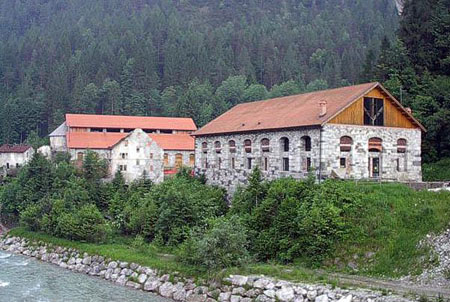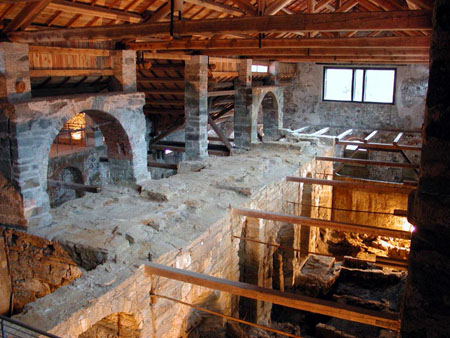| Card n. | Description | Locality | Linked sites |
| 39 | Val Imperina | Rivamonte Agordino | 83 |
| file .pdf | Industrial Archaeology (AI) | Google maps |
 |
 |
- Description
- How to get there
- Interesting facts
- Bibliography
One of the points that since 2001 has provided access to the Dolomiti Bellunesi National Park, featuring an exhibition room and a hostel, was from ancient times one of the most important mineral mining and working sites in the Belluno area. We know that cupriferous pyrite was extracted as far back as the 15th century, and that this activity continued without interruption, under various different proprietors, at such length and to such an extent that in 1788 the area was able to meet half of the total demand for copper of the Serenissima Republic of Venice. The site was composed of numerous buildings, largely rectangular in shape, some of which have been recovered and positioned at the point where the torrent that gives its name to the valley flows into the Cordevole. The most interesting, from both an architectural and historical point of view, is the building that contained the furnaces, featuring an original apse at the side. In addition to the main building plan and the former power plant now used as a Visitor Centre of the National Park, we can see the dormitory (ex CRAL), situated on the other side of the Imperina torrent, the stables, the coal warehouses (which have undergone archaeological intervention), the Youth Hostel, which provides food and accommodation, and the entrances to the two main galleries, which visitors will be able to enter in the future: the Santa Barbara entrance (dating back to the 16th century) and the Magni entrance (from the 1950s), situated in the upper part of the mine. The whole industrial system of the mining site conditioned the society and economy of the Agordino area, as well as the landscape, for centuries. Further upstream, along the flow of the Imperina torrent, there were once a series of workshops for the initial processing of the copper extracted from the Imperina mines. The site is the arrival point of one of the segments that form the Via degli ospizi route, created and maintained by the Dolomiti Bellunesi National Park which, on the right side of the Cordevole torrent, runs along the ancient route that once linked the Val Belluna with the Agordino area. At Agre a new walkway with “corten” steel braces allows hikers to cross the Cordevole, linking the Via degli Ospizi route with the ancient neighbourhood of La Muda, at the foot of Monte Zelo, and at the foot of the Col dei Ciot saddle, a pass historically controlled from the fortified village of Agordo.
Along the SR 203 Agordina, at km 23.2, after the new tunnel on the left, there is a covered wooden bridge (parking available nearby) that leads across the Cordevole to the mining buildings.
ACCESSIBLE: yes
MUNICIPALITY: Rivamonte Agordino
PLACE: Mines
GEOGRAPHICAL COORDINATES: X 1734645 – Y 5127137
PROVINCE: Belluno
FILE COMPILED BY: Antoniol
For centuries, near La Muda, there were two bridges that crossed the Cordevole: the Tornèr and Castei bridges. The name of the latter derives from the castle, or manned watchtower that once stood nearby (mentioned in documents from as far back as the 13th century) and was called Tajada de S. Martin by the locals. The site was fortified further between the 19th century and the First World War, and destroyed during the rout of Caporetto. Numerous works have been carried out in this narrow gorge, including a series of tunnels carved out for the Bribano-Agordo railway, which came out at the end of the bridge and have today been replaced by the modern “Castei” tunnel, the drilling work for which caused the drying up of the “La Pissa” waterfall that once came straight down into Cordevole at the Scalon ridge.
R. Vergani, Il centro minerario di valle Imperina (Veneto): dalla riscoperta al riuso, XIII TICCIH Congress, Terni, 2006
G. Poloniato, La via degli ospizi. Sulle antiche tracce di viandanti in val Cordevole, Feltre, 2002
W. Salton, A. Pollazzon, G. Slompo, il centro minerario di valle Imperina e il suo recupero. Veneto Region, 1995
M. Callegari, Il complesso minerario di valle Imperina (Belluno) in Archeologia industriale nel Veneto, Veneto Regional Council, Silvana Editoriale, 1990

